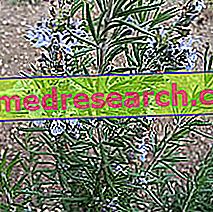Generality
Horsefly stings cause pain and discomfort and, in some cases, can transmit pathogens of various kinds.

Horseflies are insects belonging to the large group of ectoparasites and are active especially in the warm months. In detail, horsefly stings come from female specimens, because they are hematophagous.
In addition to the typical pain caused by them, horsefly bites worry about the potential transmission of bacteria and parasites which, in turn, can give rise to even very serious infectious diseases. Fortunately, the transmission of pathogens through horsefly bites does not seem to be particularly widespread in our country.
Curiosity
Horseflies are annoying insects that annoy both humans and animals and, in particular (but not only), livestock and horses. Not surprisingly, the common name of the horseflies in the English language is "horse-fly", meaning "horse flies".
Notes on the Tafans
Horseflies are temporary ectoparasites belonging to the phylum Arthropoda (arthropods), subphylum Uniramia, class Insecta (insects), order Diptera (diptera), suborder Brachicera, family Tabanidae (tabanids).
The term "horsefly" is used in a generic way to indicate different species belonging to the genera Chrysops, Tabanus and Haematopota . The most widespread species in Italy, seem to be those belonging to the last two genera mentioned.
Horseflies are insects characterized by a stocky body and a large head, they are endowed with strong and large wings, equally strong are the legs that, however, appear to be rather short.
The buccal apparatus of the horseflies is short and robust and, in female specimens, is of a perforating-sucking type; while in the male specimens - since they are not hematophagous - it is sucking but not perforating. As mentioned, gadfly bites derive only from female specimens, as they need to feed on blood during the development and / or spawning phase. The male and female specimens that do not need to take blood, on the other hand, feed on nectar.
Did you know that ...
Horsefly females seem to be particularly aggressive at the time of their blood meal. In fact, if not completely satisfied by the first bite, these annoying insects can "chase" their victim by attacking them until they can adequately complete the meal.
Features
Characteristics of horsefly stings
Horsefly stings can be very painful and the lesions induced by them appear very red and raised ( wheals ). In some cases, when the insect ends the meal and moves away from the host, there may be a slight loss of blood, this is because the saliva of the horseflies contains anticoagulant substances that prevent the blood from coagulating in order to favor the meal.
Injuries caused by horsefly bites generally heal within a few days, but in some cases may require longer healing times.
Did you know that ...
In truth, to speak of horsefly bites would not be entirely appropriate, since, rather than stinging, these insects literally tear the skin through their powerful jaws, in order to let the blood escape which is then taken through the alimentary canal.
Symptoms
What Symptoms Cause Horsefly Stings?
The main symptom caused by horsefly bites is pain, caused by the skin laceration made by the insect through the jaws. Depending on the area in which the horsefly consumes its meal, the painful stimulus can be more or less intense.
Generally, the injuries caused by horsefly bites are not itchy, but they can create a lot of discomfort and remain sore for a few hours.
As with any other insect bite, even horsefly bites can cause allergic reactions, mainly caused by the saliva of the arthropod that is inevitably injected into the host during the meal. These reactions usually occur with symptoms such as:
- Urticaria;
- Weakness;
- Dizziness;
- Dyspnoea;
- Edema.
Finally, we recall that the injuries caused by horsefly bites could become complicated, giving rise to superinfections .
Please note
If after the tafano stings you are witnessing the appearance of any of the above symptoms or other symptoms considered "atypical", you must contact your doctor immediately. In fact, it could be an allergic reaction, or, at worst, it could be infectious diseases transmitted through the same horsefly bites. In the latter case, however, the symptomatology will not appear immediately after the puncture, but after some time, depending on the type of pathogen transmitted by the insect.
Horsefly bites in animals
The characteristics and symptoms of horsefly bites in animals are very similar to those seen in humans. Therefore, even in this case, the bites will cause lesions characterized by discomfort and pain.
Transmitted pathogens
What pathogens can be transmitted through horsefly bites?
Although horsefly bites can be very painful, what is more worrying - besides the risk of suffering from overinfection of the lesions - are the potential pathogens that these troublesome insects can transmit. Below, these pathogens will be briefly listed and described.
Loa loa
Loa loa is a filiform nematode parasite belonging to the filarial group and transmitted by horseflies belonging to the genus Chrysops (in particular, C. dimidiata and C. silacea ). In detail, horseflies represent those that in parasitology define themselves as " intermediate guests ". The female specimens are infected with L. loa when - eating with the blood of infected men or animals - they take the larvae of this nematode (microfilariae). Once inside the insect, the larvae of L. loa reach the third stage of larval development, to then be transmitted to the final host (man or animal) through the subsequent horsefly bites.
Adult Loa loa individuals are located in the subcutaneous tissue, especially in the eyelids, or more commonly in the subconjunctival connective tissue (hence the common name of " eye worm ").
Generally, L. loa infections are benign, sometimes asymptomatic and sometimes cause irritation and inflammatory phenomena. However, complications are more serious. However, this type of infection does not appear to be widespread in Italy, but in Central-Western Africa.
Francisella tularensis
The Francisella tularensis is the beat responsible for tularemia, better known as " rabbit fever ". This microorganism can be transmitted by horsefly bites, but also by tick bites and flea bites. Furthermore, transmission can also take place through direct contact with infected animals (rabbits, mice, hares and squirrels).
Depending on the mode of transmission, infection with Francisella tularensis may manifest itself differently.
In the detail of the transmission through the tafano stings, the infection will initially involve the skin (formation of ulcers at the site of inoculation) and then the lymph nodes through which the pathogen can then reach the blood circulation.
Bacillus anthracis
Bacillus anthracis is the bacteria responsible for the infection known as anthrax . In truth, usually this micro-organism is transmitted by gastrointestinal route, or by air. However, even horsefly bites are suspected to be able to carry the pathogen.
Treatments and Treatments
Treatment and Treatment against Injuries induced by Horsefly Stings
As painful as they are, tafano-induced injuries tend to heal spontaneously within a few days. Eventually, it is possible to apply over-the-counter products or prescription-free medicines to the affected area, specifically formulated to combat pain and discomfort caused by insect bites and stings . However, before resorting to the use of drugs, even if freely available, it would be good to ask for the preventive advice of your doctor, in order to exclude the possible presence of contraindications to the use of the product.
Instead, to reduce the edema caused by horsefly bites, it could be useful to apply an ice pack .
If the injuries caused by the gadfly bites should not resolve within a relatively short period of time, if the lesion changes appearance (eg pus formation) and / or if unusual symptoms appear (eg fever), contact the own doctor in order to identify the presence of any superinfections.
Treatments and treatments against pathogens transmitted by horsefly bites
The care and treatment of infections transmitted by horsefly bites require the use of specific drugs that are able to counteract the pathogen responsible for the infectious disease.
In the case of infections sustained by Loa loa, the treatment involves the administration of antielmintic drugs (for example, diethylcarbamazine). In the case tafano bites have given rise to infections sustained by Francisella tularensis or by Bacillus anthracis, instead, the treatment foresees the administration of antibiotic drugs (for example, tetracyclines, penicillins or aminoglycoside antibiotics).
Prevention of horsefly stings
The best way to prevent horsefly bites is to avoid contact with the insect. Therefore, it is a good rule to avoid places where these annoying arthropods are notoriously widespread (such as stables, riding stables, etc.) and, possibly, resorting to the use of adequate insect repellents .



